BTEC HND Unit 6: Talent Management Project Report on Google and Tesco
VerifiedAdded on 2023/01/05
|19
|4218
|1
Report
AI Summary
This report provides a detailed analysis of talent management practices, focusing on a comparison between Google and Tesco. The project encompasses various aspects, including project aims and objectives, a project management plan, and a work breakdown structure with a Gantt chart. It also includes a small-scale research component, exploring both primary and secondary data collection methods. The report delves into data analysis and findings derived from the research, providing insights into Google's talent management strategies, such as recruitment, training, and retention methods. Recommendations are formulated based on the analysis, with a reflection on the value of the project in meeting the objectives. The report concludes with a summary of the findings and a list of references.
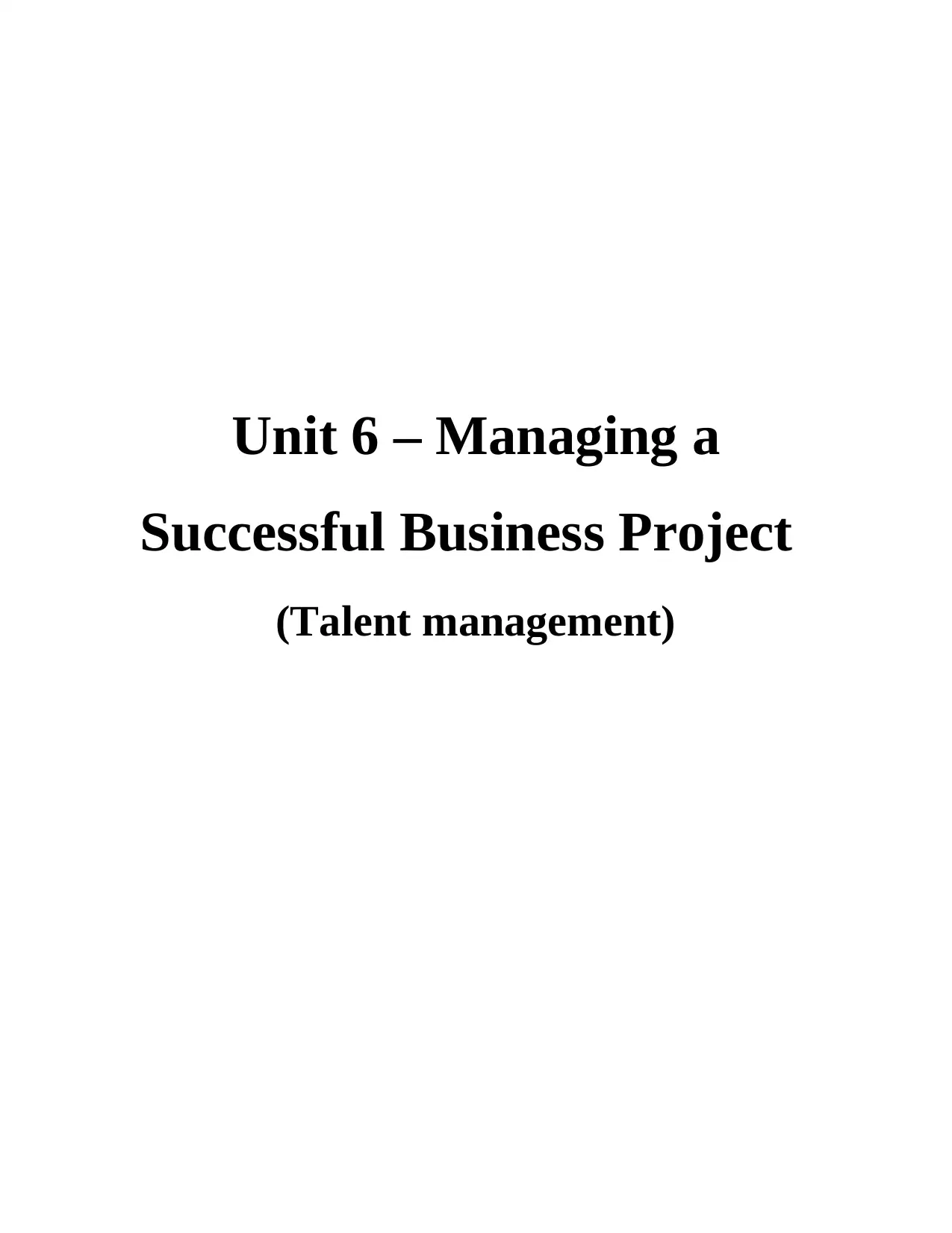
Unit 6 – Managing a
Successful Business Project
(Talent management)
Successful Business Project
(Talent management)
Paraphrase This Document
Need a fresh take? Get an instant paraphrase of this document with our AI Paraphraser
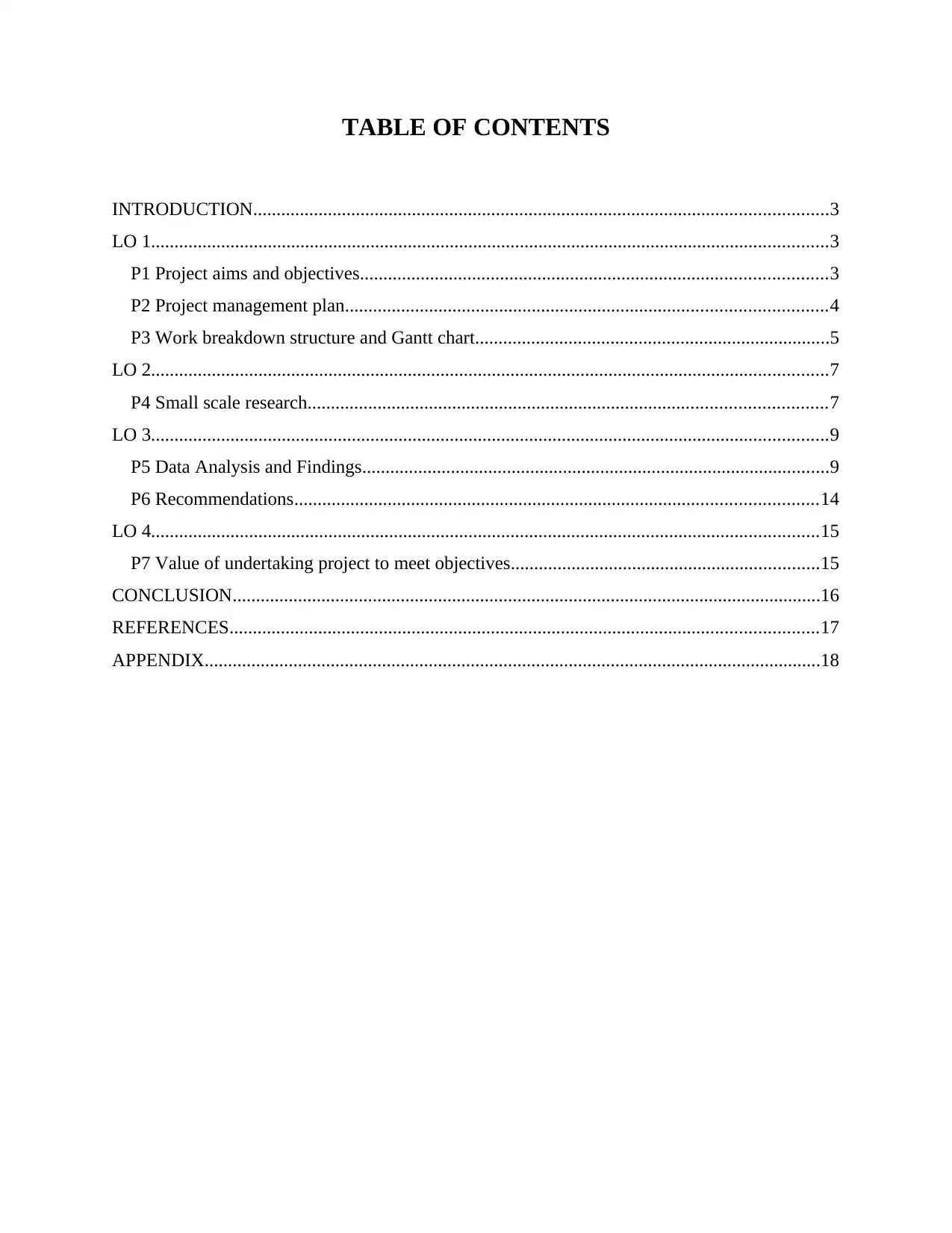
TABLE OF CONTENTS
INTRODUCTION...........................................................................................................................3
LO 1.................................................................................................................................................3
P1 Project aims and objectives....................................................................................................3
P2 Project management plan.......................................................................................................4
P3 Work breakdown structure and Gantt chart............................................................................5
LO 2.................................................................................................................................................7
P4 Small scale research...............................................................................................................7
LO 3.................................................................................................................................................9
P5 Data Analysis and Findings....................................................................................................9
P6 Recommendations................................................................................................................14
LO 4...............................................................................................................................................15
P7 Value of undertaking project to meet objectives..................................................................15
CONCLUSION..............................................................................................................................16
REFERENCES..............................................................................................................................17
APPENDIX....................................................................................................................................18
INTRODUCTION...........................................................................................................................3
LO 1.................................................................................................................................................3
P1 Project aims and objectives....................................................................................................3
P2 Project management plan.......................................................................................................4
P3 Work breakdown structure and Gantt chart............................................................................5
LO 2.................................................................................................................................................7
P4 Small scale research...............................................................................................................7
LO 3.................................................................................................................................................9
P5 Data Analysis and Findings....................................................................................................9
P6 Recommendations................................................................................................................14
LO 4...............................................................................................................................................15
P7 Value of undertaking project to meet objectives..................................................................15
CONCLUSION..............................................................................................................................16
REFERENCES..............................................................................................................................17
APPENDIX....................................................................................................................................18
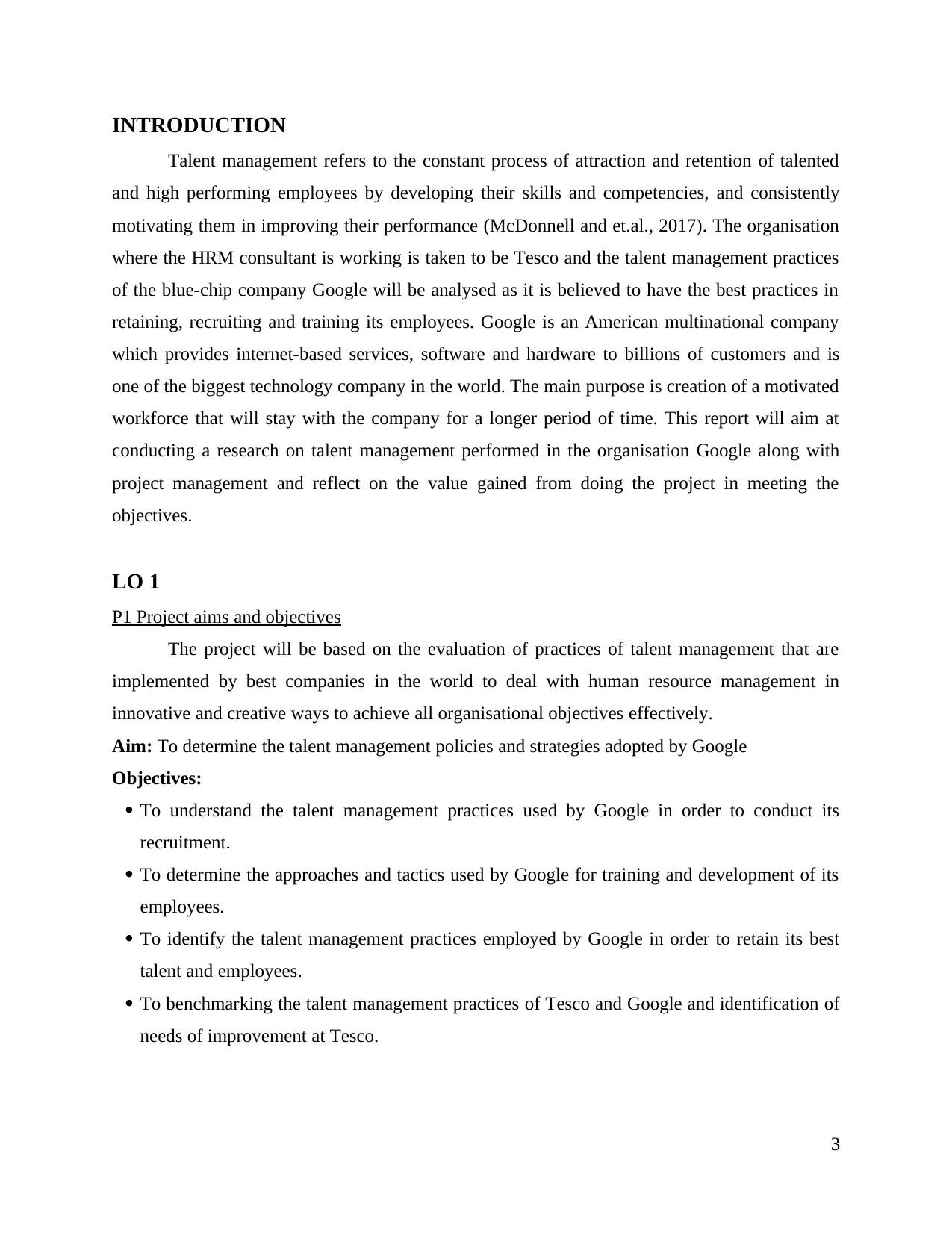
INTRODUCTION
Talent management refers to the constant process of attraction and retention of talented
and high performing employees by developing their skills and competencies, and consistently
motivating them in improving their performance (McDonnell and et.al., 2017). The organisation
where the HRM consultant is working is taken to be Tesco and the talent management practices
of the blue-chip company Google will be analysed as it is believed to have the best practices in
retaining, recruiting and training its employees. Google is an American multinational company
which provides internet-based services, software and hardware to billions of customers and is
one of the biggest technology company in the world. The main purpose is creation of a motivated
workforce that will stay with the company for a longer period of time. This report will aim at
conducting a research on talent management performed in the organisation Google along with
project management and reflect on the value gained from doing the project in meeting the
objectives.
LO 1
P1 Project aims and objectives
The project will be based on the evaluation of practices of talent management that are
implemented by best companies in the world to deal with human resource management in
innovative and creative ways to achieve all organisational objectives effectively.
Aim: To determine the talent management policies and strategies adopted by Google
Objectives:
To understand the talent management practices used by Google in order to conduct its
recruitment.
To determine the approaches and tactics used by Google for training and development of its
employees.
To identify the talent management practices employed by Google in order to retain its best
talent and employees.
To benchmarking the talent management practices of Tesco and Google and identification of
needs of improvement at Tesco.
3
Talent management refers to the constant process of attraction and retention of talented
and high performing employees by developing their skills and competencies, and consistently
motivating them in improving their performance (McDonnell and et.al., 2017). The organisation
where the HRM consultant is working is taken to be Tesco and the talent management practices
of the blue-chip company Google will be analysed as it is believed to have the best practices in
retaining, recruiting and training its employees. Google is an American multinational company
which provides internet-based services, software and hardware to billions of customers and is
one of the biggest technology company in the world. The main purpose is creation of a motivated
workforce that will stay with the company for a longer period of time. This report will aim at
conducting a research on talent management performed in the organisation Google along with
project management and reflect on the value gained from doing the project in meeting the
objectives.
LO 1
P1 Project aims and objectives
The project will be based on the evaluation of practices of talent management that are
implemented by best companies in the world to deal with human resource management in
innovative and creative ways to achieve all organisational objectives effectively.
Aim: To determine the talent management policies and strategies adopted by Google
Objectives:
To understand the talent management practices used by Google in order to conduct its
recruitment.
To determine the approaches and tactics used by Google for training and development of its
employees.
To identify the talent management practices employed by Google in order to retain its best
talent and employees.
To benchmarking the talent management practices of Tesco and Google and identification of
needs of improvement at Tesco.
3
⊘ This is a preview!⊘
Do you want full access?
Subscribe today to unlock all pages.

Trusted by 1+ million students worldwide
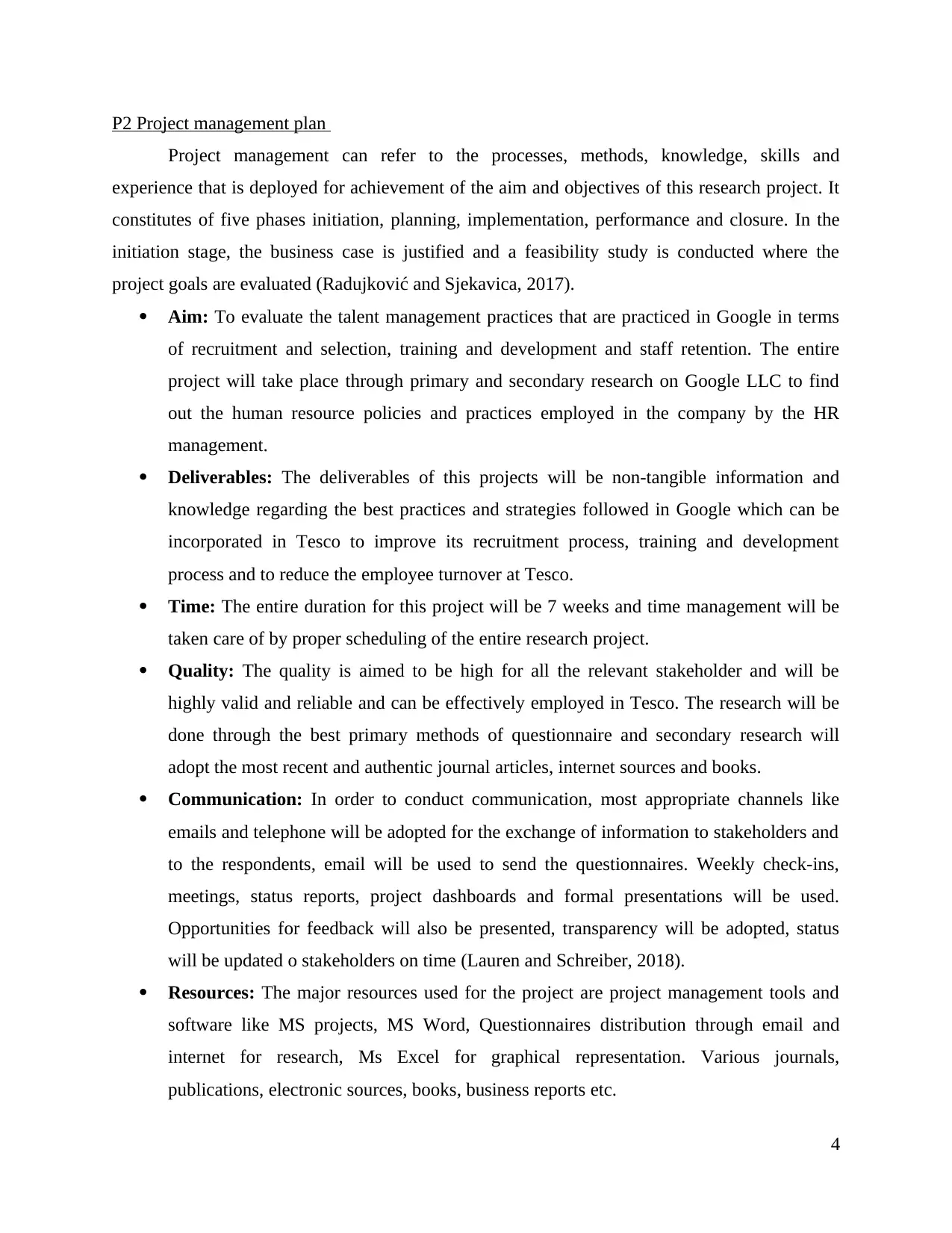
P2 Project management plan
Project management can refer to the processes, methods, knowledge, skills and
experience that is deployed for achievement of the aim and objectives of this research project. It
constitutes of five phases initiation, planning, implementation, performance and closure. In the
initiation stage, the business case is justified and a feasibility study is conducted where the
project goals are evaluated (Radujković and Sjekavica, 2017).
Aim: To evaluate the talent management practices that are practiced in Google in terms
of recruitment and selection, training and development and staff retention. The entire
project will take place through primary and secondary research on Google LLC to find
out the human resource policies and practices employed in the company by the HR
management.
Deliverables: The deliverables of this projects will be non-tangible information and
knowledge regarding the best practices and strategies followed in Google which can be
incorporated in Tesco to improve its recruitment process, training and development
process and to reduce the employee turnover at Tesco.
Time: The entire duration for this project will be 7 weeks and time management will be
taken care of by proper scheduling of the entire research project.
Quality: The quality is aimed to be high for all the relevant stakeholder and will be
highly valid and reliable and can be effectively employed in Tesco. The research will be
done through the best primary methods of questionnaire and secondary research will
adopt the most recent and authentic journal articles, internet sources and books.
Communication: In order to conduct communication, most appropriate channels like
emails and telephone will be adopted for the exchange of information to stakeholders and
to the respondents, email will be used to send the questionnaires. Weekly check-ins,
meetings, status reports, project dashboards and formal presentations will be used.
Opportunities for feedback will also be presented, transparency will be adopted, status
will be updated o stakeholders on time (Lauren and Schreiber, 2018).
Resources: The major resources used for the project are project management tools and
software like MS projects, MS Word, Questionnaires distribution through email and
internet for research, Ms Excel for graphical representation. Various journals,
publications, electronic sources, books, business reports etc.
4
Project management can refer to the processes, methods, knowledge, skills and
experience that is deployed for achievement of the aim and objectives of this research project. It
constitutes of five phases initiation, planning, implementation, performance and closure. In the
initiation stage, the business case is justified and a feasibility study is conducted where the
project goals are evaluated (Radujković and Sjekavica, 2017).
Aim: To evaluate the talent management practices that are practiced in Google in terms
of recruitment and selection, training and development and staff retention. The entire
project will take place through primary and secondary research on Google LLC to find
out the human resource policies and practices employed in the company by the HR
management.
Deliverables: The deliverables of this projects will be non-tangible information and
knowledge regarding the best practices and strategies followed in Google which can be
incorporated in Tesco to improve its recruitment process, training and development
process and to reduce the employee turnover at Tesco.
Time: The entire duration for this project will be 7 weeks and time management will be
taken care of by proper scheduling of the entire research project.
Quality: The quality is aimed to be high for all the relevant stakeholder and will be
highly valid and reliable and can be effectively employed in Tesco. The research will be
done through the best primary methods of questionnaire and secondary research will
adopt the most recent and authentic journal articles, internet sources and books.
Communication: In order to conduct communication, most appropriate channels like
emails and telephone will be adopted for the exchange of information to stakeholders and
to the respondents, email will be used to send the questionnaires. Weekly check-ins,
meetings, status reports, project dashboards and formal presentations will be used.
Opportunities for feedback will also be presented, transparency will be adopted, status
will be updated o stakeholders on time (Lauren and Schreiber, 2018).
Resources: The major resources used for the project are project management tools and
software like MS projects, MS Word, Questionnaires distribution through email and
internet for research, Ms Excel for graphical representation. Various journals,
publications, electronic sources, books, business reports etc.
4
Paraphrase This Document
Need a fresh take? Get an instant paraphrase of this document with our AI Paraphraser
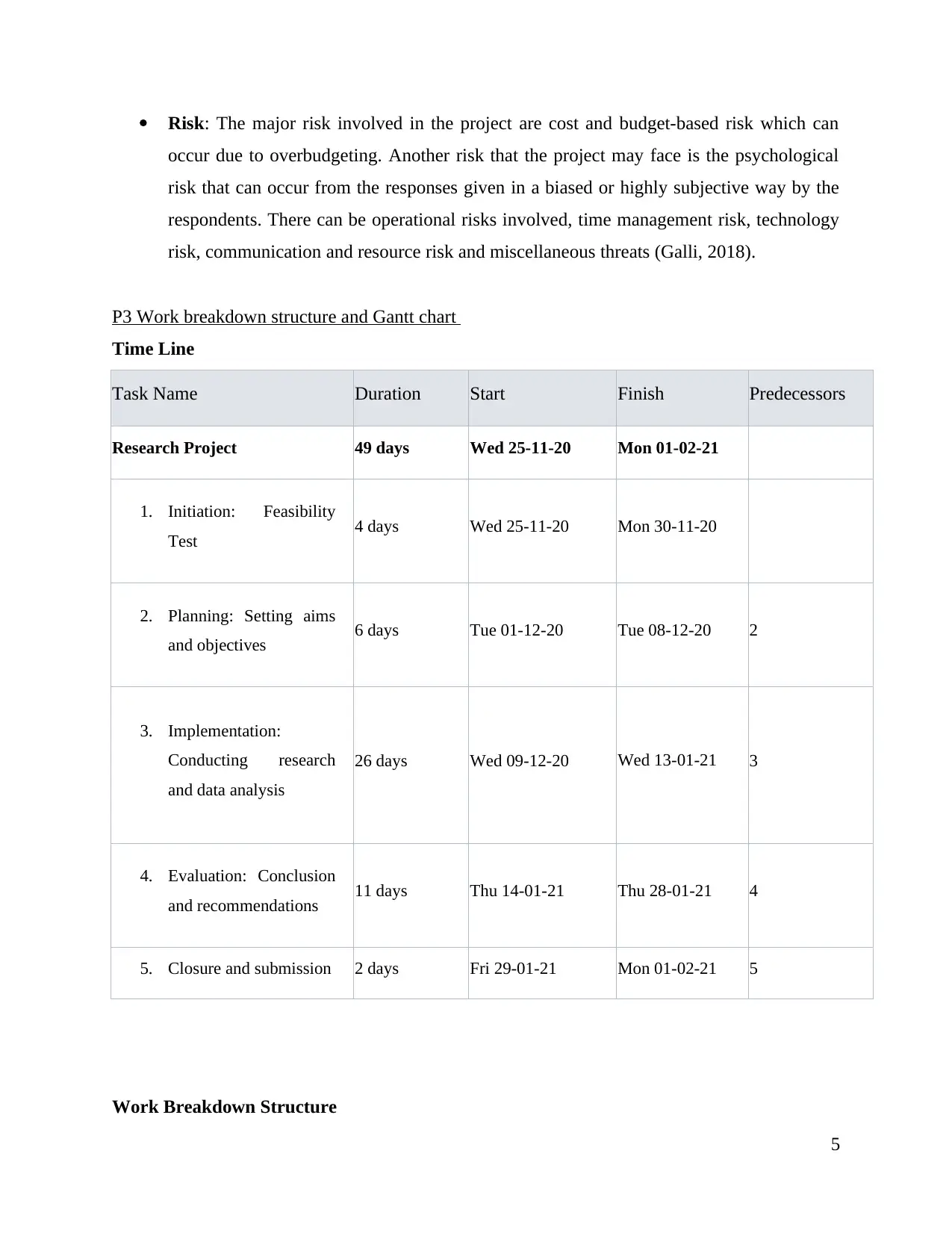
Risk: The major risk involved in the project are cost and budget-based risk which can
occur due to overbudgeting. Another risk that the project may face is the psychological
risk that can occur from the responses given in a biased or highly subjective way by the
respondents. There can be operational risks involved, time management risk, technology
risk, communication and resource risk and miscellaneous threats (Galli, 2018).
P3 Work breakdown structure and Gantt chart
Time Line
Task Name Duration Start Finish Predecessors
Research Project 49 days Wed 25-11-20 Mon 01-02-21
1. Initiation: Feasibility
Test 4 days Wed 25-11-20 Mon 30-11-20
2. Planning: Setting aims
and objectives 6 days Tue 01-12-20 Tue 08-12-20 2
3. Implementation:
Conducting research
and data analysis
26 days Wed 09-12-20 Wed 13-01-21 3
4. Evaluation: Conclusion
and recommendations 11 days Thu 14-01-21 Thu 28-01-21 4
5. Closure and submission 2 days Fri 29-01-21 Mon 01-02-21 5
Work Breakdown Structure
5
occur due to overbudgeting. Another risk that the project may face is the psychological
risk that can occur from the responses given in a biased or highly subjective way by the
respondents. There can be operational risks involved, time management risk, technology
risk, communication and resource risk and miscellaneous threats (Galli, 2018).
P3 Work breakdown structure and Gantt chart
Time Line
Task Name Duration Start Finish Predecessors
Research Project 49 days Wed 25-11-20 Mon 01-02-21
1. Initiation: Feasibility
Test 4 days Wed 25-11-20 Mon 30-11-20
2. Planning: Setting aims
and objectives 6 days Tue 01-12-20 Tue 08-12-20 2
3. Implementation:
Conducting research
and data analysis
26 days Wed 09-12-20 Wed 13-01-21 3
4. Evaluation: Conclusion
and recommendations 11 days Thu 14-01-21 Thu 28-01-21 4
5. Closure and submission 2 days Fri 29-01-21 Mon 01-02-21 5
Work Breakdown Structure
5
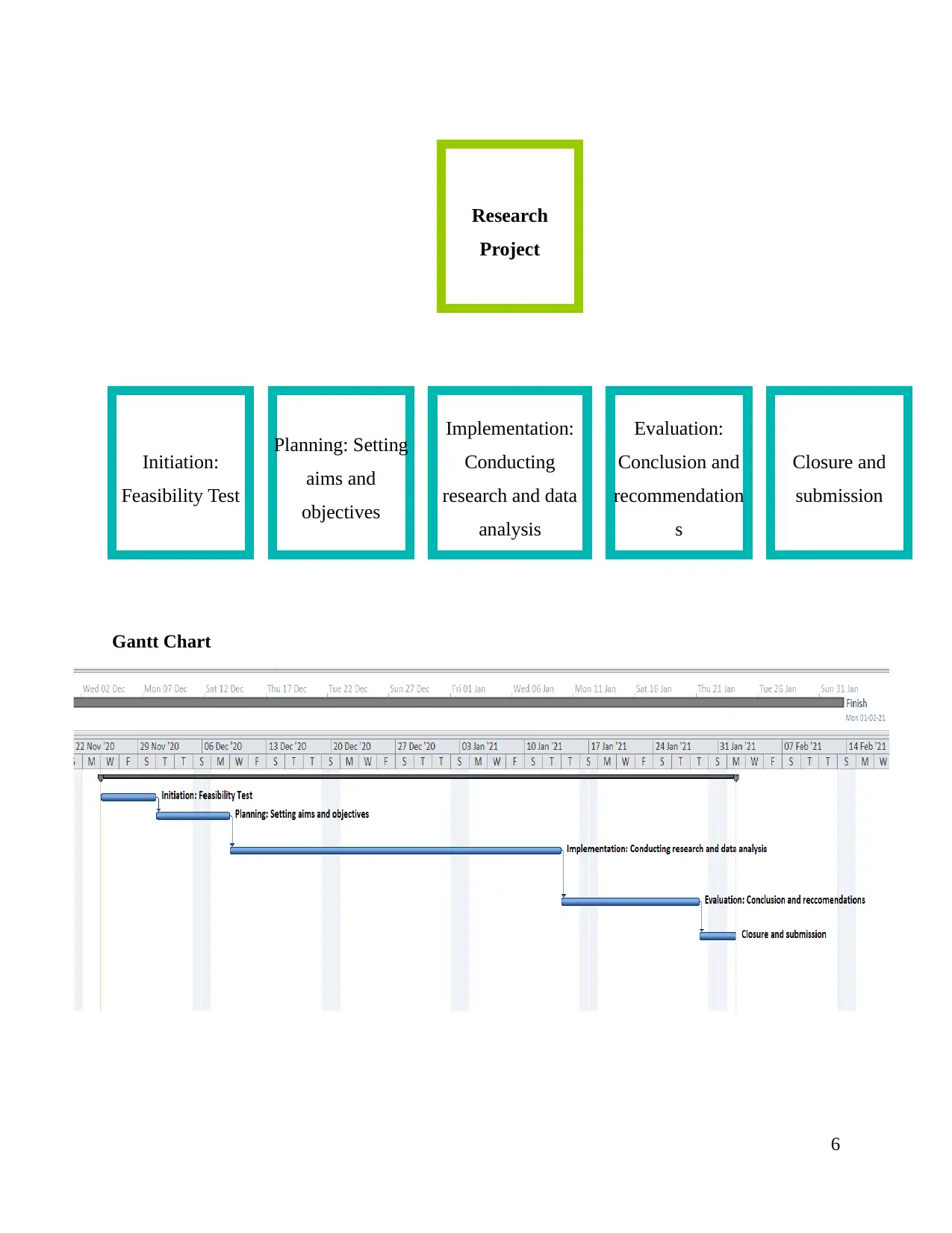
Gantt Chart
6
Research
Project
Initiation:
Feasibility Test
Planning: Setting
aims and
objectives
Implementation:
Conducting
research and data
analysis
Evaluation:
Conclusion and
recommendation
s
Closure and
submission
6
Research
Project
Initiation:
Feasibility Test
Planning: Setting
aims and
objectives
Implementation:
Conducting
research and data
analysis
Evaluation:
Conclusion and
recommendation
s
Closure and
submission
⊘ This is a preview!⊘
Do you want full access?
Subscribe today to unlock all pages.

Trusted by 1+ million students worldwide
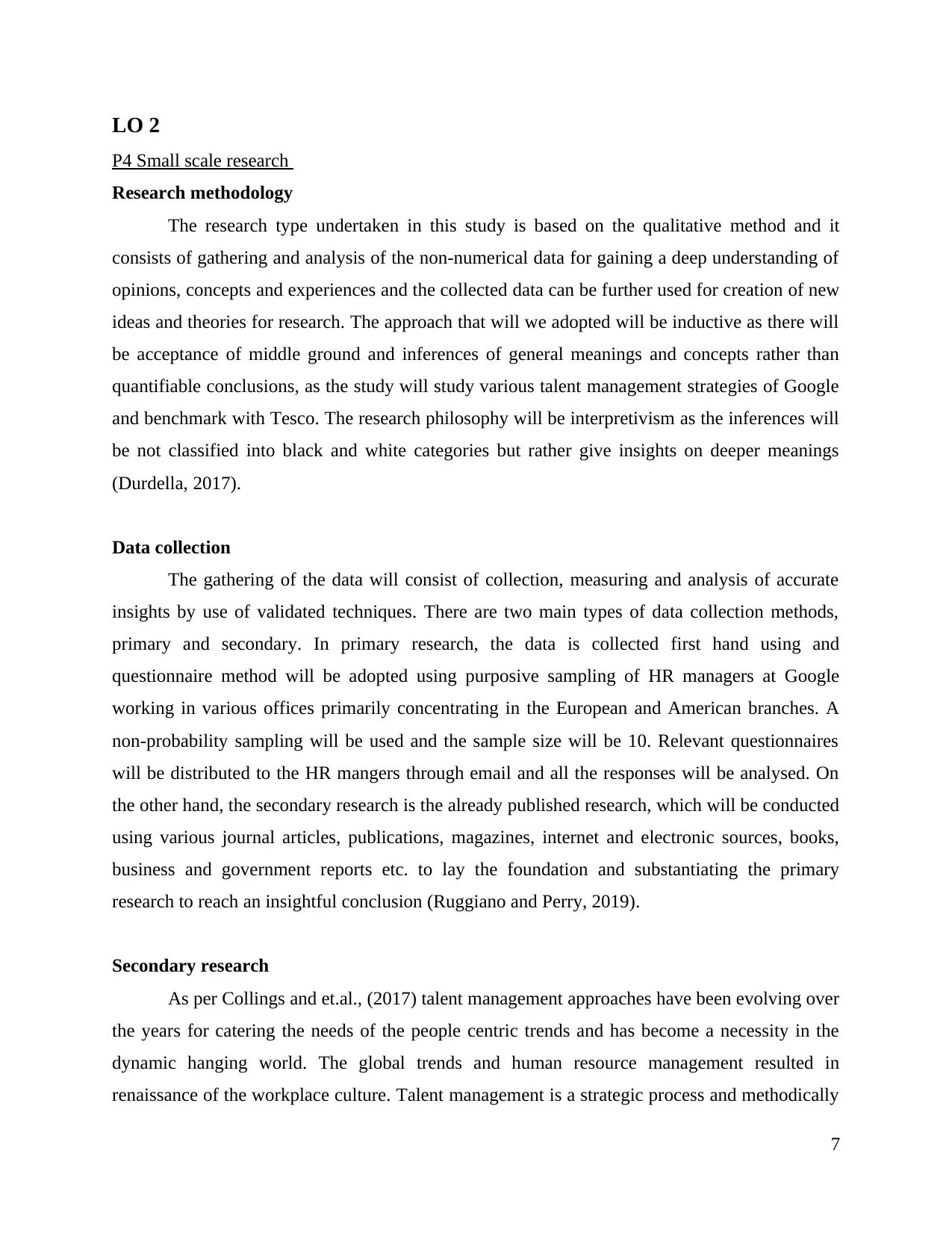
LO 2
P4 Small scale research
Research methodology
The research type undertaken in this study is based on the qualitative method and it
consists of gathering and analysis of the non-numerical data for gaining a deep understanding of
opinions, concepts and experiences and the collected data can be further used for creation of new
ideas and theories for research. The approach that will we adopted will be inductive as there will
be acceptance of middle ground and inferences of general meanings and concepts rather than
quantifiable conclusions, as the study will study various talent management strategies of Google
and benchmark with Tesco. The research philosophy will be interpretivism as the inferences will
be not classified into black and white categories but rather give insights on deeper meanings
(Durdella, 2017).
Data collection
The gathering of the data will consist of collection, measuring and analysis of accurate
insights by use of validated techniques. There are two main types of data collection methods,
primary and secondary. In primary research, the data is collected first hand using and
questionnaire method will be adopted using purposive sampling of HR managers at Google
working in various offices primarily concentrating in the European and American branches. A
non-probability sampling will be used and the sample size will be 10. Relevant questionnaires
will be distributed to the HR mangers through email and all the responses will be analysed. On
the other hand, the secondary research is the already published research, which will be conducted
using various journal articles, publications, magazines, internet and electronic sources, books,
business and government reports etc. to lay the foundation and substantiating the primary
research to reach an insightful conclusion (Ruggiano and Perry, 2019).
Secondary research
As per Collings and et.al., (2017) talent management approaches have been evolving over
the years for catering the needs of the people centric trends and has become a necessity in the
dynamic hanging world. The global trends and human resource management resulted in
renaissance of the workplace culture. Talent management is a strategic process and methodically
7
P4 Small scale research
Research methodology
The research type undertaken in this study is based on the qualitative method and it
consists of gathering and analysis of the non-numerical data for gaining a deep understanding of
opinions, concepts and experiences and the collected data can be further used for creation of new
ideas and theories for research. The approach that will we adopted will be inductive as there will
be acceptance of middle ground and inferences of general meanings and concepts rather than
quantifiable conclusions, as the study will study various talent management strategies of Google
and benchmark with Tesco. The research philosophy will be interpretivism as the inferences will
be not classified into black and white categories but rather give insights on deeper meanings
(Durdella, 2017).
Data collection
The gathering of the data will consist of collection, measuring and analysis of accurate
insights by use of validated techniques. There are two main types of data collection methods,
primary and secondary. In primary research, the data is collected first hand using and
questionnaire method will be adopted using purposive sampling of HR managers at Google
working in various offices primarily concentrating in the European and American branches. A
non-probability sampling will be used and the sample size will be 10. Relevant questionnaires
will be distributed to the HR mangers through email and all the responses will be analysed. On
the other hand, the secondary research is the already published research, which will be conducted
using various journal articles, publications, magazines, internet and electronic sources, books,
business and government reports etc. to lay the foundation and substantiating the primary
research to reach an insightful conclusion (Ruggiano and Perry, 2019).
Secondary research
As per Collings and et.al., (2017) talent management approaches have been evolving over
the years for catering the needs of the people centric trends and has become a necessity in the
dynamic hanging world. The global trends and human resource management resulted in
renaissance of the workplace culture. Talent management is a strategic process and methodically
7
Paraphrase This Document
Need a fresh take? Get an instant paraphrase of this document with our AI Paraphraser
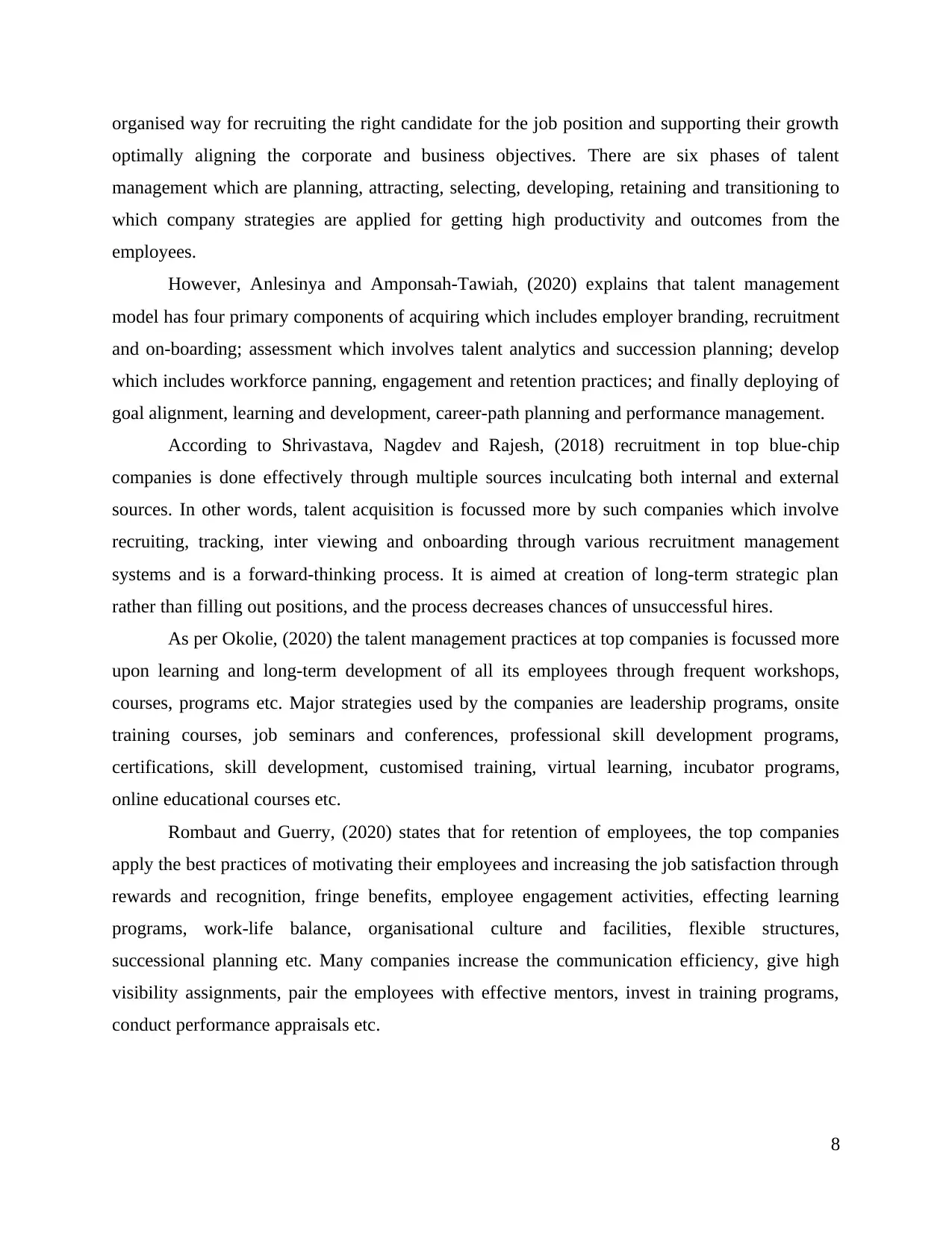
organised way for recruiting the right candidate for the job position and supporting their growth
optimally aligning the corporate and business objectives. There are six phases of talent
management which are planning, attracting, selecting, developing, retaining and transitioning to
which company strategies are applied for getting high productivity and outcomes from the
employees.
However, Anlesinya and Amponsah-Tawiah, (2020) explains that talent management
model has four primary components of acquiring which includes employer branding, recruitment
and on-boarding; assessment which involves talent analytics and succession planning; develop
which includes workforce panning, engagement and retention practices; and finally deploying of
goal alignment, learning and development, career-path planning and performance management.
According to Shrivastava, Nagdev and Rajesh, (2018) recruitment in top blue-chip
companies is done effectively through multiple sources inculcating both internal and external
sources. In other words, talent acquisition is focussed more by such companies which involve
recruiting, tracking, inter viewing and onboarding through various recruitment management
systems and is a forward-thinking process. It is aimed at creation of long-term strategic plan
rather than filling out positions, and the process decreases chances of unsuccessful hires.
As per Okolie, (2020) the talent management practices at top companies is focussed more
upon learning and long-term development of all its employees through frequent workshops,
courses, programs etc. Major strategies used by the companies are leadership programs, onsite
training courses, job seminars and conferences, professional skill development programs,
certifications, skill development, customised training, virtual learning, incubator programs,
online educational courses etc.
Rombaut and Guerry, (2020) states that for retention of employees, the top companies
apply the best practices of motivating their employees and increasing the job satisfaction through
rewards and recognition, fringe benefits, employee engagement activities, effecting learning
programs, work-life balance, organisational culture and facilities, flexible structures,
successional planning etc. Many companies increase the communication efficiency, give high
visibility assignments, pair the employees with effective mentors, invest in training programs,
conduct performance appraisals etc.
8
optimally aligning the corporate and business objectives. There are six phases of talent
management which are planning, attracting, selecting, developing, retaining and transitioning to
which company strategies are applied for getting high productivity and outcomes from the
employees.
However, Anlesinya and Amponsah-Tawiah, (2020) explains that talent management
model has four primary components of acquiring which includes employer branding, recruitment
and on-boarding; assessment which involves talent analytics and succession planning; develop
which includes workforce panning, engagement and retention practices; and finally deploying of
goal alignment, learning and development, career-path planning and performance management.
According to Shrivastava, Nagdev and Rajesh, (2018) recruitment in top blue-chip
companies is done effectively through multiple sources inculcating both internal and external
sources. In other words, talent acquisition is focussed more by such companies which involve
recruiting, tracking, inter viewing and onboarding through various recruitment management
systems and is a forward-thinking process. It is aimed at creation of long-term strategic plan
rather than filling out positions, and the process decreases chances of unsuccessful hires.
As per Okolie, (2020) the talent management practices at top companies is focussed more
upon learning and long-term development of all its employees through frequent workshops,
courses, programs etc. Major strategies used by the companies are leadership programs, onsite
training courses, job seminars and conferences, professional skill development programs,
certifications, skill development, customised training, virtual learning, incubator programs,
online educational courses etc.
Rombaut and Guerry, (2020) states that for retention of employees, the top companies
apply the best practices of motivating their employees and increasing the job satisfaction through
rewards and recognition, fringe benefits, employee engagement activities, effecting learning
programs, work-life balance, organisational culture and facilities, flexible structures,
successional planning etc. Many companies increase the communication efficiency, give high
visibility assignments, pair the employees with effective mentors, invest in training programs,
conduct performance appraisals etc.
8
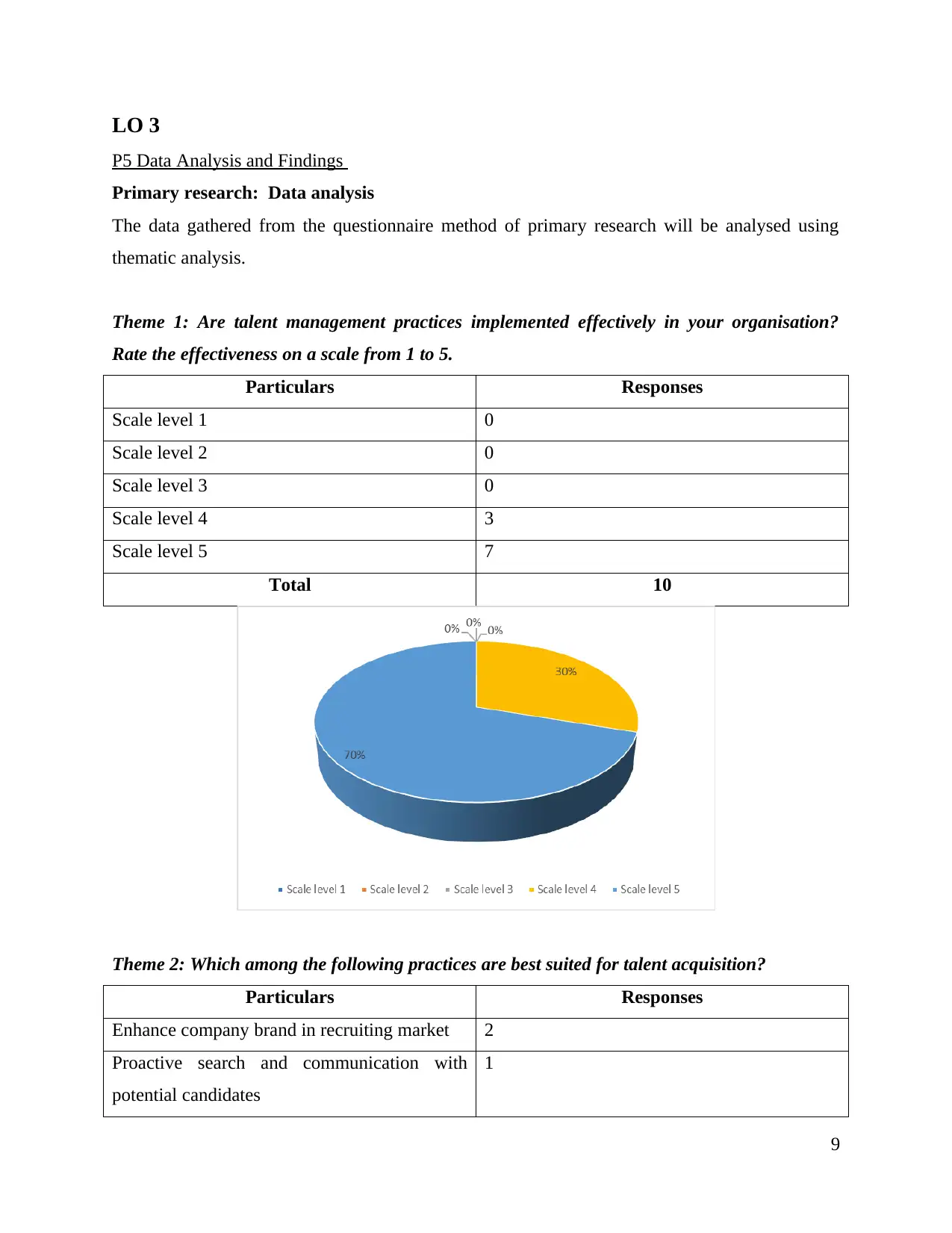
LO 3
P5 Data Analysis and Findings
Primary research: Data analysis
The data gathered from the questionnaire method of primary research will be analysed using
thematic analysis.
Theme 1: Are talent management practices implemented effectively in your organisation?
Rate the effectiveness on a scale from 1 to 5.
Particulars Responses
Scale level 1 0
Scale level 2 0
Scale level 3 0
Scale level 4 3
Scale level 5 7
Total 10
Theme 2: Which among the following practices are best suited for talent acquisition?
Particulars Responses
Enhance company brand in recruiting market 2
Proactive search and communication with
potential candidates
1
9
P5 Data Analysis and Findings
Primary research: Data analysis
The data gathered from the questionnaire method of primary research will be analysed using
thematic analysis.
Theme 1: Are talent management practices implemented effectively in your organisation?
Rate the effectiveness on a scale from 1 to 5.
Particulars Responses
Scale level 1 0
Scale level 2 0
Scale level 3 0
Scale level 4 3
Scale level 5 7
Total 10
Theme 2: Which among the following practices are best suited for talent acquisition?
Particulars Responses
Enhance company brand in recruiting market 2
Proactive search and communication with
potential candidates
1
9
⊘ This is a preview!⊘
Do you want full access?
Subscribe today to unlock all pages.

Trusted by 1+ million students worldwide
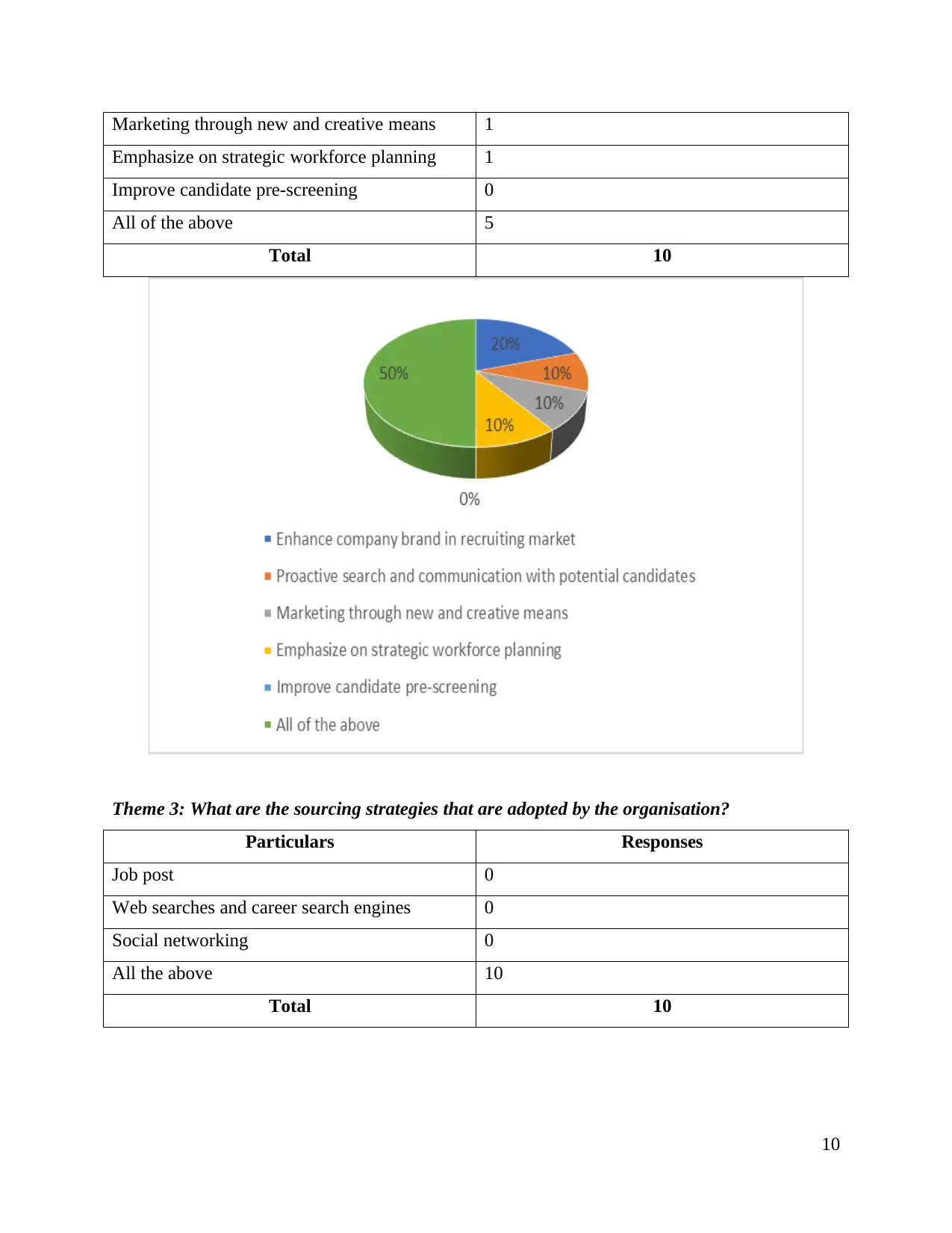
Marketing through new and creative means 1
Emphasize on strategic workforce planning 1
Improve candidate pre-screening 0
All of the above 5
Total 10
Theme 3: What are the sourcing strategies that are adopted by the organisation?
Particulars Responses
Job post 0
Web searches and career search engines 0
Social networking 0
All the above 10
Total 10
10
Emphasize on strategic workforce planning 1
Improve candidate pre-screening 0
All of the above 5
Total 10
Theme 3: What are the sourcing strategies that are adopted by the organisation?
Particulars Responses
Job post 0
Web searches and career search engines 0
Social networking 0
All the above 10
Total 10
10
Paraphrase This Document
Need a fresh take? Get an instant paraphrase of this document with our AI Paraphraser
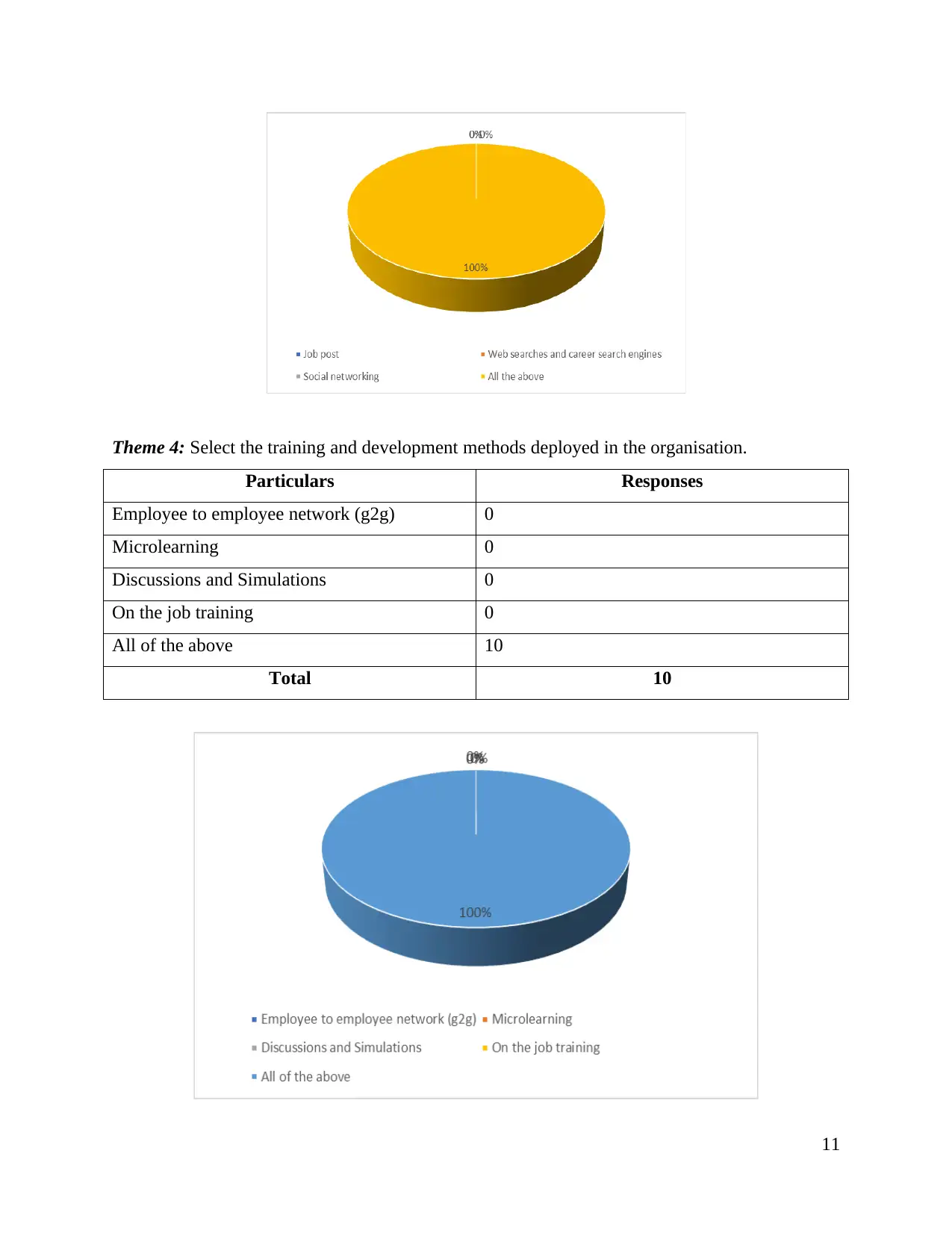
Theme 4: Select the training and development methods deployed in the organisation.
Particulars Responses
Employee to employee network (g2g) 0
Microlearning 0
Discussions and Simulations 0
On the job training 0
All of the above 10
Total 10
11
Particulars Responses
Employee to employee network (g2g) 0
Microlearning 0
Discussions and Simulations 0
On the job training 0
All of the above 10
Total 10
11
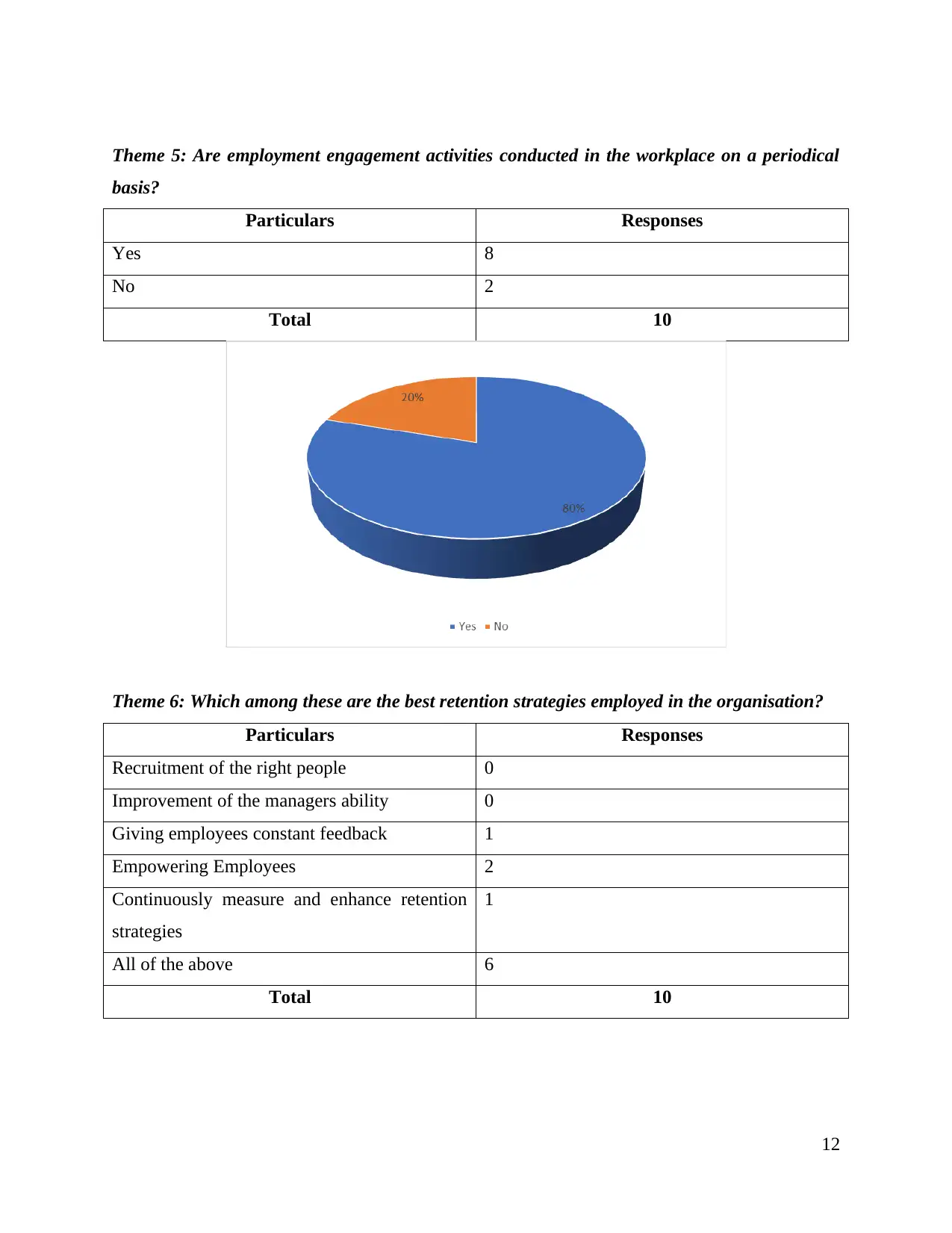
Theme 5: Are employment engagement activities conducted in the workplace on a periodical
basis?
Particulars Responses
Yes 8
No 2
Total 10
Theme 6: Which among these are the best retention strategies employed in the organisation?
Particulars Responses
Recruitment of the right people 0
Improvement of the managers ability 0
Giving employees constant feedback 1
Empowering Employees 2
Continuously measure and enhance retention
strategies
1
All of the above 6
Total 10
12
basis?
Particulars Responses
Yes 8
No 2
Total 10
Theme 6: Which among these are the best retention strategies employed in the organisation?
Particulars Responses
Recruitment of the right people 0
Improvement of the managers ability 0
Giving employees constant feedback 1
Empowering Employees 2
Continuously measure and enhance retention
strategies
1
All of the above 6
Total 10
12
⊘ This is a preview!⊘
Do you want full access?
Subscribe today to unlock all pages.

Trusted by 1+ million students worldwide
1 out of 19
Related Documents
Your All-in-One AI-Powered Toolkit for Academic Success.
+13062052269
info@desklib.com
Available 24*7 on WhatsApp / Email
![[object Object]](/_next/static/media/star-bottom.7253800d.svg)
Unlock your academic potential
Copyright © 2020–2025 A2Z Services. All Rights Reserved. Developed and managed by ZUCOL.





